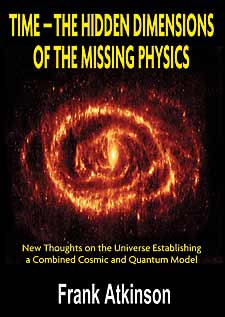Part VI
Time, Energy and Power.
Scientists devised the units for energy and power exclusively for our Earth-time before we acquired our understanding of time variation. Fortunately, while they are units that are designed to work in a flat uniform Earth-time, they fulfil the essential requirement of working equally well in any other time dilation. The unit of energy is the joule, which is a unit of electrical energy equal to the work done when a current of one amp is passed through a resistance of one ohm for one second. The unit of power is the watt, which is equal to one joule per second. In each case, time is an essential element of the unit. In both cases their values 'in-comparative-terms' will alter with the variation in time, increasing and decreasing respectively with its dilation and contraction.
So the situation exists where energy, which equates to frequency and also therefore, the speed of light, together increase with time dilation. It now becomes imperative to reconsider the equation E=mc². No longer can we think of the mass 'm' as a variable and the speed of light as a constant - their true roles are reversed. It must be the case that energy is a function of the dilated time of the mass 'm'. The mass 'm' can now remain constant while its time dilates. The speed of light in the equation is merely the factor that indicates the degree of time dilation. The incorrect interpretation of the equation has in the past been of little consequence. It was approximately correct for an almost constant value of time on Earth where variations in time are small.
Consider however, a space pilot taking a trip at a speed that is a substantial proportion of the speed of light on Earth. Let us reflect on what happens, first under the rules of general relativity and then under the rules of the Tempo field theory. It would be the case in both instances, that regardless of his time dilation, the normal number and size of meals he eats in the course of his respective twenty four hours remains consistent. It is important to note here that under general relativity as the spaceship's speed goes up the time dilates and the mass of the food, along with everything else on the spaceship, supposedly increases. Fortunately, in the Tempo field theory the mass of the meals, and everything else, would remain unaltered. If it were not so, the pilot's dilated time would have dire consequences for him.
It is common ground that the interval between meals on the spaceship of five or six hours could in comparative Earth-time be stretched to as many weeks. The amount of energy each meal contains, needs to be the same for the contracted Earth-time as well as the dilated spaceship-time.
General relativity presumes to resolve the problem by increasing the mass of each meal by an amount equal to the increase in its energy of motion. Unfortunately, the increased mass of a meal in the pilot's gut, in proportion to the increase in energy of motion, would cause medical problems for him and taken to extremes would be fatal. When in the past, such arguments have been put forward against general relativity, scientists have been unwilling to consider the possibility that they were misinterpreting the equation E=mc². They merely threw up their hands and said that it just goes to show that people cannot travel at relativistic speeds. However, such a dubious and anomalous response does not stand up, as it is not only insupportable physiologically but also mathematically. The argument that the increase in the food's mass is required to give enough energy to sustain the pilot's body over the stretched amount of time, fails mathematically because his body mass also increases, thereby cancelling out the looked for effect.
As reasoned in the Tempo field theory, what actually happens is that the energy content of the food, expressed in joules, remains the same in all time dilations. The necessary accommodation takes place by means of the time element of the joules dilating as appropriate. As mentioned above, one joule is the energy required to pass one amp across a resistance of one ohm in one second. It is this second that dilates, maintaining a harmonious conformity with the dilation of time of everything in the spaceship, including the pilot and his stomach.
Click here to read Part 7 of this Digest, on 'Time and Quantum Physics'.

